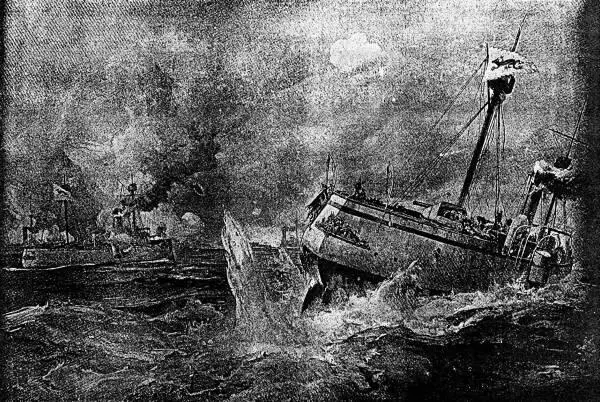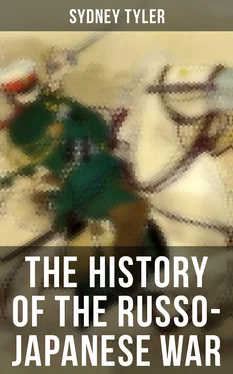Notwithstanding the conclusion of the Anglo-Japanese Treaty of Alliance in the beginning of 1902, Japan waited for eighteen months before entering into the diplomatic lists alone against Russia. But at last, in August of 1903, this course was rendered imperative upon her, not only by the failure of the Czar's Government to carry out their engagements in regard to Manchuria, but by their aggressive policy in Korea. M. Pavloff, rebuffed at Masampo in 1900, had turned his energies in another direction. He secured for his countrymen valuable mining rights in Northern Korea, and Russians then began to cross the Yalu River and ultimately occupied Yongampo, a town of some importance on the southern bank. Not content with railway enterprises, they even started to construct fortifications. The Japanese, of course, interposed energetically and succeeded in modifying the Russian activity; but it now became apparent that, unless some binding arrangement could be arrived at, Korea was destined to share the fate of Manchuria.
Representations were therefore made at St. Petersburg calling for a revision of the Treaties of 1896 and 1898, and a friendly settlement of the respective rights of the two Powers. The story of the negotiations which ensued is a simple one. It is a story of courteous and moderate representation on the one side, and of studied delay and contemptuous refusals on the other. The negotiations on behalf of Russia were in the hands of Admiral Alexeieff, now elevated to the position of Viceroy of the East, and it is said to be mainly due to his influence that his Government adopted such an unbending attitude. Japan asked for a repetition by Russia of the pledges she had given that she would recognize the integrity and independence of China and Korea; and, further, that she should recognize the preponderance of Japanese political and commercial interests in Korea. Russia haughtily refused to give Japan any pledge as to the integrity of China, and contended that her position in Manchuria was regulated by treaties with China in which Japan had no right to interfere. As to Korea, she proposed the establishment of a neutral zone in the north of the province, leaving the south of the country to become a sphere of commercial influence for Japan, but she expressly stipulated that the latter Power should make no use of any portion of Korean territory for strategic purposes. The proposal was so absurdly one-sided that Japan returned to the charge with the suggestion that a neutral zone should be established both on the Manchurian and the Korean sides of the frontier. She also reiterated her request for an agreement as to the maintenance of the territorial integrity of Manchuria and China.
Russia contemptuously delayed reply to these representations in spite of the courteous requests of the Japanese Government. In the meanwhile she kept augmenting her forces in the Far East till the situation became impossible of continuance.
Every day that passed threatened to transfer the balance of naval power in favor of the European Power, for a powerful fleet was being hurried out to the Far East, and the badly-finished warships in Port Arthur were being patched up by an army of mechanicians. Mr. Kurino, who conducted the negotiations at St. Petersburg, pressed for an answer, but was put off with promises no less than six times. Such discourtesy could only have one result. The dignity of Japan could brook no further insolence, and the Czar and his Ministers were politely informed that under such circumstances negotiations were useless. It was in vain that hurried telegrams were dispatched to Admiral Alexeieff to present a reply to the justly incensed Cabinet at Tokio. The die had been cast, and the big bully of the North, who had for so long baited the plucky little Japanese, realized at last that threats and bluff no longer were of any avail, and that the matter was now referred to the God of Battles.
On February 7th, 1904, Japan formally broke off the negotiations and withdrew her Minister from St. Petersburg. The war cloud had burst.

BATTLE OF THE YALU—SINKING OF THE CHIH-YUEN.
Table of Contents
The growing menace of the situation in the Far East had been for months attracting the anxious attention of the whole world, and at the beginning of 1904 it became evident that war was inevitable, unless one or other of the disputants was prepared to make a complete surrender of its essential claims. The unlikelihood of this remote possibility being fulfilled was confirmed by the steady and, on the Russian side at least, the feverish preparations for hostilities which were carried on as an accompaniment to the repeated protestations of pacific intentions by the Czar's Government and its diplomatic agents abroad. Those who still believed in peace were sustained by the conviction that one of the parties to the dispute was bluffing. Sympathizers with Russia pointed to the tremendous power and inexhaustible resources of the Northern Empire, and asked whether it were possible that a young and small country like Japan should dare to try conclusions with so gigantic an antagonist. On the other hand, the friends of Japan emphasized the weakness of the Russian position in the Far East and the well-known financial embarrassments beneath which her Exchequer was laboring. It is, therefore, apropos to survey at this point the military and strategic position in the Far East which revealed itself immediately before the final rupture of diplomatic negotiations and the beginning of active hostilities.
In any conflict between Russia and Japan it was obvious that the first struggle must be for the mastery of the sea, and it is, therefore, interesting to consider primarily the relative naval strength of the two Powers in Far Eastern waters. The navy of Japan has been built, not only on English models, but for the most part in English yards; and since the Chino-Japanese War it has been increased by a number of vessels of the latest and most powerful type. The result is that the most formidable feature of Japan's naval strength is its complete homogeneity. The tabular statement on page 41, gives the names and principal characteristics of what may be called Japan's first fighting line at sea.
Towards the close of 1903 the Japanese Government, with great enterprise, managed to secure a powerful accession to this fleet by purchasing from Argentina two freshly constructed cruisers of the most modern and efficient type. These two vessels, which have been re-christened the Nisshin and Kasaga , were hastily equipped for sea at Genoa, and, commanded for the time being by retired English officers and manned by English crews, started in January for the long voyage to the Far East. Although war had not yet been declared, it was clearly imminent, and the Russian squadron in the Mediterranean received orders to watch the new cruisers closely, with the object, of course, of capturing them in case hostilities broke out before the vessels had reached Japan. The taste of their quality, however, which the Nisshin and Kasaga were able to give to the Russians proved how valuable an addition they were to the Japanese navy, for they easily outdistanced their slow-footed pursuers, and what promised at one time to be an exciting race degenerated practically into a walk over. The new cruisers arrived safely at Yokohama on February 16th, and were at once sent into dock to refit and prepare for active service. These splendid fighting machines must, therefore, be added to the list.
JAPAN'S UP-TO-DATE NAVY.
| BATTLESHIPS. |
|
|
|
|
Nominal |
Gun |
Weight of |
| Name |
Displacement |
I.H.P. |
Speed |
Protection |
Broadside Fire |
| Hatsuse |
15,000 |
15,000 |
18.0 |
14—6 |
4,240 |
| Asahi |
15,000 |
15,000 |
18.0 |
14—6 |
4,240 |
| Shikishima |
15,000 |
15,000 |
18.0 |
14—6 |
4,240 |
| Mikasa |
15,200 |
16,000 |
18.0 |
14—6 |
4,225 |
| Yashima |
12,300 |
13,000 |
18.0 |
14—6 |
4,000 |
| Fuji |
12,300 |
13,000 |
18.0 |
14—6 |
4,000 |
|
| ARMORED CRUISERS. |
|
| Tokiwa |
9,750 |
18,000 |
21.5 |
6—6 |
3,568 |
| Asama |
9,750 |
18,000 |
21.5 |
6—6 |
3,568 |
| Yakuma |
9,850 |
16,000 |
20.0 |
6—6 |
3,368 |
| Adzuma |
9,436 |
17,000 |
21.0 |
6—6 |
3,368 |
| Idzumo |
9,800 |
15,000 |
24.7 |
6—6 |
3,568 |
| Iwate |
9,800 |
15,000 |
24.7 |
6—6 |
3,568 |
|
| PROTECTED CRUISERS. |
|
| Takasago |
4,300 |
15,500 |
24.0 |
4-1/2—2 |
800 |
| Kasagi |
4,784 |
15,500 |
22.5 |
4-1/2 |
800 |
| Chitose |
4,784 |
15,500 |
22.5 |
4-1/2 |
800 |
| Itsukushima |
4,277 |
5,400 |
16.7 |
11—4 |
1,260 |
| Hashidate |
4,277 |
5,400 |
16.7 |
11—4 |
1,260 |
| Matsushima |
4,277 |
5,400 |
16.7 |
11—4 |
1,260 |
| Yoshino |
4,180 |
15,750 |
23.0 |
— |
780 |
| Naniwa |
3,727 |
7,120 |
17.8 |
— |
1,196 |
| Takachiho |
3,727 |
7,120 |
17.8 |
— |
1,196 |
| Akitsushima |
3,150 |
8,400 |
19.0 |
— |
780 |
| Niitaka |
3,420 |
9,500 |
20.0 |
— |
920 |
| Tsushima |
3,420 |
9,500 |
20.0 |
— |
920 |
| Suma |
3,700 |
8,500 |
20.0 |
— |
335 |
| Akashi |
2,700 |
8,500 |
20.0 |
— |
335 |
The table, it will be observed, does not include a number of coast defence vessels, nor—more important for offensive purposes—the torpedo flotilla, which is of great strength and of remarkable efficiency, and includes over a score of 30-knot destroyers of the most modern type. The first four battleships in the list were completed less than two years before the war, while the armored cruisers were built between 1899 and 1901. The protected cruisers include several of the vessels that defeated the Chinese fleet at the battle of the Yalu.
Читать дальше













